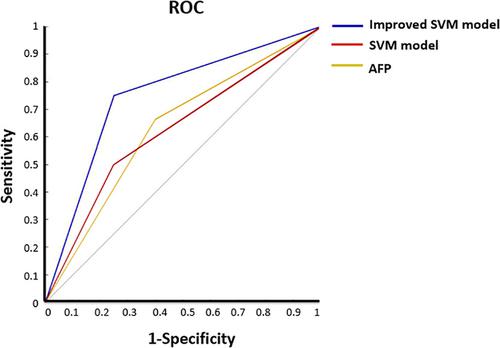当前位置:
X-MOL 学术
›
Ann. N. Y. Acad. Sci.
›
论文详情
Our official English website, www.x-mol.net, welcomes your feedback! (Note: you will need to create a separate account there.)
Complement factors and alpha‐fetoprotein as biomarkers for noninvasive prenatal diagnosis of neural tube defects
Annals of the New York Academy of Sciences ( IF 5.2 ) Pub Date : 2020-08-05 , DOI: 10.1111/nyas.14443 Naixuan Dong 1, 2 , Hui Gu 1 , Dan Liu 1 , Xiaowei Wei 1 , Wei Ma 1 , Ling Ma 1 , Yusi Liu 1 , Yanfu Wang 1 , Shanshan Jia 1 , Jieting Huang 1 , Chenfei Wang 1 , Xuan He 2 , Tianchu Huang 1 , Yiwen He 1 , Qiang Zhang 3 , Dong An 4 , Yuzuo Bai 5 , Zhengwei Yuan 1
Annals of the New York Academy of Sciences ( IF 5.2 ) Pub Date : 2020-08-05 , DOI: 10.1111/nyas.14443 Naixuan Dong 1, 2 , Hui Gu 1 , Dan Liu 1 , Xiaowei Wei 1 , Wei Ma 1 , Ling Ma 1 , Yusi Liu 1 , Yanfu Wang 1 , Shanshan Jia 1 , Jieting Huang 1 , Chenfei Wang 1 , Xuan He 2 , Tianchu Huang 1 , Yiwen He 1 , Qiang Zhang 3 , Dong An 4 , Yuzuo Bai 5 , Zhengwei Yuan 1
Affiliation

|
Neural tube defects (NTDs) are serious congenital malformations. In this study, we aimed to identify more specific and sensitive maternal serum biomarkers for noninvasive NTD screenings. We collected serum from 37 pregnant women carrying fetuses with NTDs and 38 pregnant women carrying normal fetuses. Isobaric tags for relative and absolute quantitation were conducted for differential proteomic analysis, and an enzyme‐linked immunosorbent assay was used to validate the results. We then used a support vector machine (SVM) classifier to establish a disease prediction model for NTD diagnosis. We identified 113 differentially expressed proteins; of these, 23 were either up‐ or downregulated 1.5‐fold or more, including five complement proteins (C1QA, C1S, C1R, C9, and C3); C3 and C9 were downregulated significantly in NTD groups. The accuracy rate of the SVM model of the complement factors (including C1QA, C1S, and C3) was 62.5%, with 60% sensitivity and 67% specificity, while the accuracy rate of the SVM model of alpha‐fetoprotein (AFP, an established biomarker for NTDs) was 62.5%, with 75% sensitivity and 50% specificity. Combination of the complement factor and AFP data resulted in the SVM model accuracy of 75%, and receiver operating characteristic curve analysis showed 75% sensitivity and 75% specificity. These data suggest that a disease prediction model based on combined complement factor and AFP data could serve as a more accurate method of noninvasive prenatal NTD diagnosis.
中文翻译:

补体因子和甲胎蛋白作为神经管缺陷无创产前诊断的生物标志物
神经管缺陷 (NTD) 是严重的先天畸形。在这项研究中,我们旨在为无创 NTD 筛查确定更特异和更敏感的母体血清生物标志物。我们收集了 37 名怀有 NTD 胎儿的孕妇和 38 名怀有正常胎儿的孕妇的血清。进行相对和绝对定量的等压标签进行差异蛋白质组学分析,并使用酶联免疫吸附测定来验证结果。然后,我们使用支持向量机 (SVM) 分类器建立用于 NTD 诊断的疾病预测模型。我们鉴定了 113 个差异表达的蛋白质;其中,23 个被上调或下调 1.5 倍或更多,包括五种补体蛋白(C1QA、C1S、C1R、C9 和 C3);C3 和 C9 在 NTD 组中显着下调。补体因子(包括 C1QA、C1S 和 C3)SVM 模型的准确率为 62.5%,敏感性为 60%,特异性为 67%,而甲胎蛋白(AFP,已建立的NTD 的生物标志物)为 62.5%,敏感性为 75%,特异性为 50%。补体因子和 AFP 数据的组合导致 SVM 模型的准确率为 75%,接受者操作特征曲线分析显示 75% 的敏感性和 75% 的特异性。这些数据表明,基于联合补体因子和 AFP 数据的疾病预测模型可以作为一种更准确的无创产前 NTD 诊断方法。已建立的 NTD 生物标志物)为 62.5%,敏感性为 75%,特异性为 50%。补体因子和 AFP 数据的组合导致 SVM 模型的准确率为 75%,接受者操作特征曲线分析显示 75% 的敏感性和 75% 的特异性。这些数据表明,基于联合补体因子和 AFP 数据的疾病预测模型可以作为一种更准确的无创产前 NTD 诊断方法。已建立的 NTD 生物标志物)为 62.5%,敏感性为 75%,特异性为 50%。补体因子和 AFP 数据的组合导致 SVM 模型的准确率为 75%,接受者操作特征曲线分析显示 75% 的敏感性和 75% 的特异性。这些数据表明,基于联合补体因子和 AFP 数据的疾病预测模型可以作为一种更准确的无创产前 NTD 诊断方法。
更新日期:2020-08-05
中文翻译:

补体因子和甲胎蛋白作为神经管缺陷无创产前诊断的生物标志物
神经管缺陷 (NTD) 是严重的先天畸形。在这项研究中,我们旨在为无创 NTD 筛查确定更特异和更敏感的母体血清生物标志物。我们收集了 37 名怀有 NTD 胎儿的孕妇和 38 名怀有正常胎儿的孕妇的血清。进行相对和绝对定量的等压标签进行差异蛋白质组学分析,并使用酶联免疫吸附测定来验证结果。然后,我们使用支持向量机 (SVM) 分类器建立用于 NTD 诊断的疾病预测模型。我们鉴定了 113 个差异表达的蛋白质;其中,23 个被上调或下调 1.5 倍或更多,包括五种补体蛋白(C1QA、C1S、C1R、C9 和 C3);C3 和 C9 在 NTD 组中显着下调。补体因子(包括 C1QA、C1S 和 C3)SVM 模型的准确率为 62.5%,敏感性为 60%,特异性为 67%,而甲胎蛋白(AFP,已建立的NTD 的生物标志物)为 62.5%,敏感性为 75%,特异性为 50%。补体因子和 AFP 数据的组合导致 SVM 模型的准确率为 75%,接受者操作特征曲线分析显示 75% 的敏感性和 75% 的特异性。这些数据表明,基于联合补体因子和 AFP 数据的疾病预测模型可以作为一种更准确的无创产前 NTD 诊断方法。已建立的 NTD 生物标志物)为 62.5%,敏感性为 75%,特异性为 50%。补体因子和 AFP 数据的组合导致 SVM 模型的准确率为 75%,接受者操作特征曲线分析显示 75% 的敏感性和 75% 的特异性。这些数据表明,基于联合补体因子和 AFP 数据的疾病预测模型可以作为一种更准确的无创产前 NTD 诊断方法。已建立的 NTD 生物标志物)为 62.5%,敏感性为 75%,特异性为 50%。补体因子和 AFP 数据的组合导致 SVM 模型的准确率为 75%,接受者操作特征曲线分析显示 75% 的敏感性和 75% 的特异性。这些数据表明,基于联合补体因子和 AFP 数据的疾病预测模型可以作为一种更准确的无创产前 NTD 诊断方法。


























 京公网安备 11010802027423号
京公网安备 11010802027423号